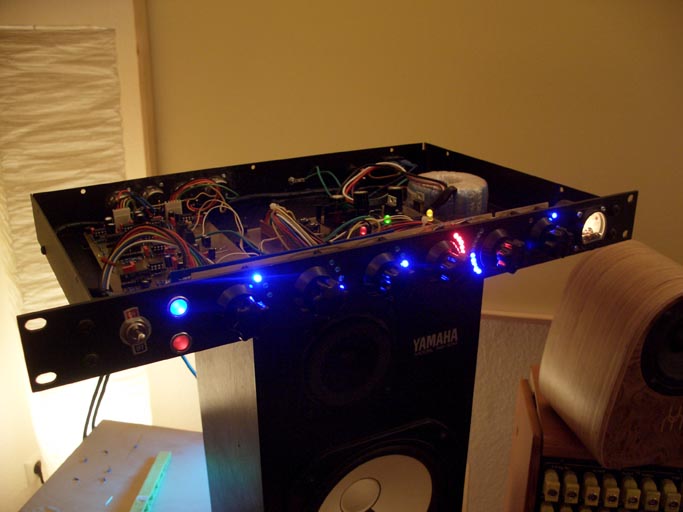YEAAH! It Works!
A bit of getting up to speed on what's been going on:
Implementing the PPM meter led me to redesigning the entire control board so that I could fit everything on it. Main reason for this was that I needed the bypass on the right to be on the same board in order to make sure all the LEDs have their little heads popping through the front panel. You need pressure from both sides to get it right (the one in the picture above was stitched together).
There are a few things I learned while I was at it. First and foremost, selection of chips:
3914 : linear
3915 : -3dB steps
3916 : -20, -10, -7, -5, -3, -1, 0, 1, 2, 3dB (which is the VU scale).
They don't SAY this in the datasheet.
This led to some major aarrgh because I wouldn't have known a VU scale if it had hit me over the head. I called up Nat Sem and the guy told me "well, that's a very old part, the guy who designed it is no longer on this earth".
very reassuring :?
Anyway, the main reason I called them is that I tried setting Vref (btw do americans really use the index V for voltage as opposed to U in Germany?) and it turns out that as long as you want your top LED to light at +4dBu, you're ok (well, sort of...). But if you want, for example, to work to -6 dBu into your DAC you can forget the internal reference. It doesn't go below 1.2V, and any attempt to calculate a divider below that leads to such adventurous resistances as "-380Ω".
So, all the internal ref was good for was for setting LED brightness (resistor off Rout around 1.2k does the job well) and short Radj to GND.
So you need to build two precision dividers (as in "Vishay" and "64") in order to set an external ref window that keeps with the dynamic range of your IC. Simply using one for refHi and shorting RefLo to GND does NOT do the trick because your 3dB increment goes to gehenna.
Stable 12.28mV DC source, anyone?
But like all these stories it worked out just fine, and I learned a lot about dB along the way. An interesting question would be: What would you like your little meter to indicate: straight dB steps or something more VU-esque? I can imagine that for things like Classical, you're better off with 3dB steps, as they have a wide dynamic range, for rock n' shit you might go for the VU because with all that compression, being able to read out 6 dB over 5 LEDs is a real advantage. As Bungie once said, "youth is only satisfied with major damage and total carnage" :twisted:
That you can change that by poppin' chips is just awesome. LM39xx designer, wherever you are, here's to you :sam:
I'll be posting some pictures later :grin:
edit: The 3916 is a lot more fun! For most music, all you'll get out of that 15 is some 3-LED action...



